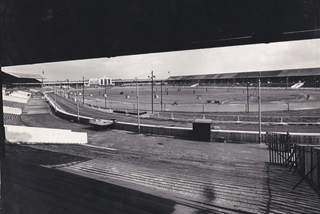
Portobello is a coastal suburb of Edinburgh in eastern central Scotland. It lies 3 miles (5 km) east of the city centre, facing the Firth of Forth, between the suburbs of Joppa and Craigentinny. Although historically it was a town in its own right, it is officially a residential suburb of Edinburgh. The promenade fronts onto a wide sandy beach.

White City Stadium in London, England, was built for the 1908 Summer Olympics. It hosted the finish of the first modern marathon and swimming, speedway, boxing, show jumping, athletics, stock car racing, concerts and a match at the 1966 World Cup.
Harringay Stadium was a major greyhound racing and motorcycle speedway venue in Harringay, north London. It was built and opened in 1927 and closed in 1987.

Granton is a district in the north of Edinburgh, Scotland. Granton forms part of Edinburgh's waterfront along the Firth of Forth and is, historically, an industrial area having a large harbour. Granton is part of Edinburgh's large scale waterfront regeneration programme.

Cliftonhill Stadium, commonly known as Cliftonhill and currently 'The Reigart Stadium' for sponsorship purposes, is a football stadium in Coatbridge, North Lanarkshire, Scotland. It is the home ground of former Scottish Professional Football League team Albion Rovers F.C., who have played at the ground since 1919.

West Ham Stadium existed between 1928 and 1972 in Custom House, east London, England, on Prince Regent Lane, near the present-day Prince Regent DLR station.

The Edinburgh Monarchs are a Scottish speedway team based in Armadale. They compete in the SGB Championship, racing on Friday nights during the speedway season. The club is run by a board of directors, chaired by Alex Harkess and also runs a National Development League team called the Monarchs Academy.

Belle Vue Stadium was a greyhound racing track in Belle Vue, Manchester, England, where the first race around an oval track in Britain was held on 24 July 1926. It has also been used for motorcycle speedway, as the home ground of Elite League team Belle Vue Aces from 1988 until 2015, and from 1999 until 2019 for stock car racing and banger racing.

New Cross Stadium, Hornshay Street, Old Kent Road, in South East London was opened in the early 1900s as an athletic stadium but was mainly used for greyhound racing and speedway. The ground was adjacent to The Old Den, the then home of Millwall F.C. and was used as a training ground by the club when they did not have facilities of their own. The track was often referred to as 'The Frying Pan'. It was built inside the greyhound track and had banking all the way round. At the time of its closure in 1969 the stadium had a capacity of 26,000. The stadium was demolished in 1975.
The Nottingham speedway team competed in the 1930s, with a home track on Trent Lane, Nottingham.

Powderhall Stadium, formerly the Powderhall Grounds, was a multi-sports facility overlooking the Water of Leith on Beaverhall Road, in the Powderhall (Broughton) area of northern Edinburgh, Scotland. It opened in January 1870 at the height of professional pedestrianism and was modelled on the stadium at Stamford Bridge in London. It hosted professional sprint races, track and field athletics, including the Scottish Amateur Athletics Championships on a number of occasions, professional football, international rugby, cycling, and dog races as well as boxing, quoits and pigeon shooting. For 100 years it hosted the Powderhall Sprint, the most famous professional sprint handicap in the world. With the decline of pedestrianism as a spectator sport in the 1920s it was converted to a greyhound stadium, hosting the Scottish Grand National for over sixty five years, and it also hosted professional speedway. The stadium finally closed in 1995 and the site is now a housing estate.

Portsmouth Greyhound Stadium was a greyhound racing stadium in Tipner north west of Portsmouth, England.
Fullerton Park was a former speedway and greyhound track in Leeds.
White City Stadium (Nottingham) was a greyhound racing and motorcycle speedway stadium in Trent Lane, Nottingham.

Reading Stadium (Oxford Road) was a greyhound racing stadium and short lived speedway venue in Reading.
Pennycross Stadium was a greyhound racing and speedway stadium in north Plymouth, Devon.
Portsmouth Greyhound Track (Copnor) also known as the Wessex Stadium was a greyhound racing and motorcycle speedway track in Portsmouth.
Stenhouse Stadium was a greyhound racing track and trotting track in Edinburgh.
White City Stadium was a greyhound racing and speedway stadium in Old Trafford, Greater Manchester, England.
Edinburgh Street Recreation Ground was a former football and greyhound racing track Edinburgh Street, Gorse Hill, Swindon, Wiltshire.











